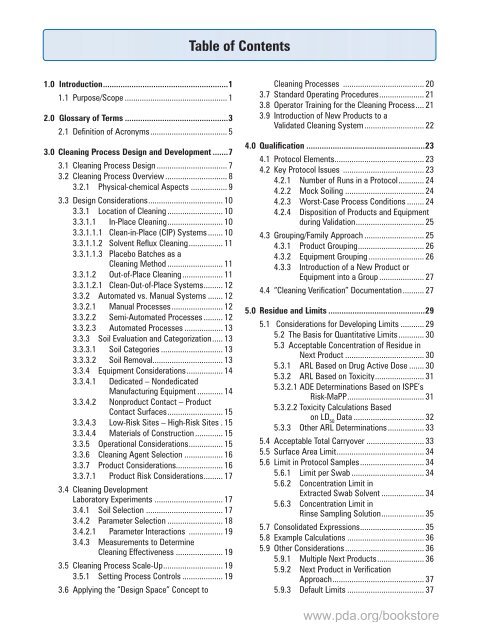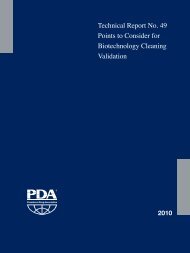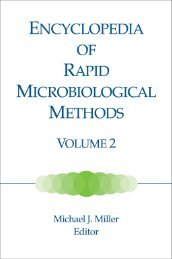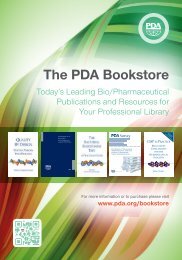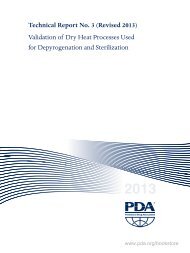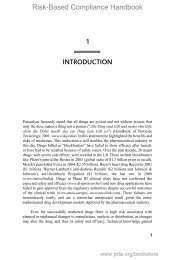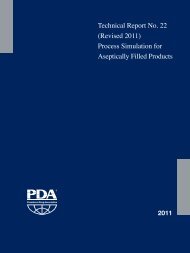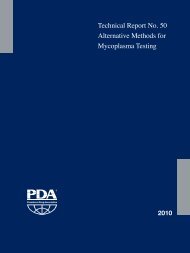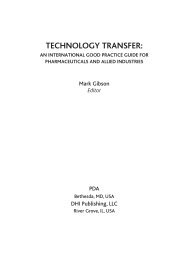Table of Contents - store.pda.org - Parenteral Drug Association
Table of Contents - store.pda.org - Parenteral Drug Association
Table of Contents - store.pda.org - Parenteral Drug Association
Create successful ePaper yourself
Turn your PDF publications into a flip-book with our unique Google optimized e-Paper software.
<strong>Table</strong> <strong>of</strong> <strong>Contents</strong><br />
1.0 Introduction..........................................................1<br />
1.1 Purpose/Scope................................................. 1<br />
2.0 Glossary <strong>of</strong> Terms................................................3<br />
2.1 Definition <strong>of</strong> Acronyms..................................... 5<br />
3.0 Cleaning Process Design and Development........7<br />
3.1 Cleaning Process Design.................................. 7<br />
3.2 Cleaning Process Overview.............................. 8<br />
3.2.1 Physical-chemical Aspects ................. 9<br />
3.3 Design Considerations.................................... 10<br />
3.3.1 Location <strong>of</strong> Cleaning........................... 10<br />
3.3.1.1 In-Place Cleaning........................... 10<br />
3.3.1.1.1 Clean-in-Place (CIP) Systems........ 10<br />
3.3.1.1.2 Solvent Reflux Cleaning................. 11<br />
3.3.1.1.3 Placebo Batches as a<br />
Cleaning Method........................... 11<br />
3.3.1.2 Out-<strong>of</strong>-Place Cleaning.................... 11<br />
3.3.1.2.1 Clean-Out-<strong>of</strong>-Place Systems.......... 12<br />
3.3.2 Automated vs. Manual Systems........ 12<br />
3.3.2.1 Manual Processes......................... 12<br />
3.3.2.2 Semi-Automated Processes.......... 12<br />
3.3.2.3 Automated Processes................... 13<br />
3.3.3 Soil Evaluation and Categorization...... 13<br />
3.3.3.1 Soil Categories.............................. 13<br />
3.3.3.2 Soil Removal................................. 13<br />
3.3.4 Equipment Considerations.................. 14<br />
3.3.4.1 Dedicated – Nondedicated<br />
Manufacturing Equipment............. 14<br />
3.3.4.2 Nonproduct Contact – Product<br />
Contact Surfaces........................... 15<br />
3.3.4.3 Low-Risk Sites – High-Risk Sites.. 15<br />
3.3.4.4 Materials <strong>of</strong> Construction.............. 15<br />
3.3.5 Operational Considerations................. 15<br />
3.3.6 Cleaning Agent Selection................... 16<br />
3.3.7 Product Considerations...................... 16<br />
3.3.7.1 Product Risk Considerations.......... 17<br />
3.4 Cleaning Development<br />
Laboratory Experiments ................................. 17<br />
3.4.1 Soil Selection ..................................... 17<br />
3.4.2 Parameter Selection........................... 18<br />
3.4.2.1 Parameter Interactions ................. 19<br />
3.4.3 Measurements to Determine<br />
Cleaning Effectiveness....................... 19<br />
3.5 Cleaning Process Scale-Up............................. 19<br />
3.5.1 Setting Process Controls.................... 19<br />
3.6 Applying the “Design Space” Concept to<br />
Cleaning Processes ....................................... 20<br />
3.7 Standard Operating Procedures...................... 21<br />
3.8 Operator Training for the Cleaning Process..... 21<br />
3.9 Introduction <strong>of</strong> New Products to a<br />
Validated Cleaning System............................. 22<br />
4.0 Qualification.......................................................23<br />
4.1 Protocol Elements........................................... 23<br />
4.2 Key Protocol Issues ....................................... 23<br />
4.2.1 Number <strong>of</strong> Runs in a Protocol............. 24<br />
4.2.2 Mock Soiling...................................... 24<br />
4.2.3 Worst-Case Process Conditions......... 24<br />
4.2.4 Disposition <strong>of</strong> Products and Equipment<br />
during Validation................................. 25<br />
4.3 Grouping/Family Approach............................. 25<br />
4.3.1 Product Grouping................................ 26<br />
4.3.2 Equipment Grouping........................... 26<br />
4.3.3 Introduction <strong>of</strong> a New Product or<br />
Equipment into a Group...................... 27<br />
4.4 “Cleaning Verification” Documentation........... 27<br />
5.0 Residue and Limits.............................................29<br />
5.1 Considerations for Developing Limits............ 29<br />
5.2 The Basis for Quantitative Limits............. 30<br />
5.3 Acceptable Concentration <strong>of</strong> Residue in<br />
Next Product...................................... 30<br />
5.3.1 ARL Based on <strong>Drug</strong> Active Dose........ 30<br />
5.3.2 ARL Based on Toxicity........................ 31<br />
5.3.2.1 ADE Determinations Based on ISPE’s<br />
Risk-MaPP..................................... 31<br />
5.3.2.2 Toxicity Calculations Based<br />
on LD 50<br />
Data.................................. 32<br />
5.3.3 Other ARL Determinations.................. 33<br />
5.4 Acceptable Total Carryover............................ 33<br />
5.5 Surface Area Limit.......................................... 34<br />
5.6 Limit in Protocol Samples............................... 34<br />
5.6.1 Limit per Swab................................... 34<br />
5.6.2 Concentration Limit in<br />
Extracted Swab Solvent..................... 34<br />
5.6.3 Concentration Limit in<br />
Rinse Sampling Solution..................... 35<br />
5.7 Consolidated Expressions............................... 35<br />
5.8 Example Calculations..................................... 36<br />
5.9 Other Considerations...................................... 36<br />
5.9.1 Multiple Next Products....................... 36<br />
5.9.2 Next Product in Verification<br />
Approach............................................ 37<br />
5.9.3 Default Limits..................................... 37<br />
www.<strong>pda</strong>.<strong>org</strong>/book<strong>store</strong>


